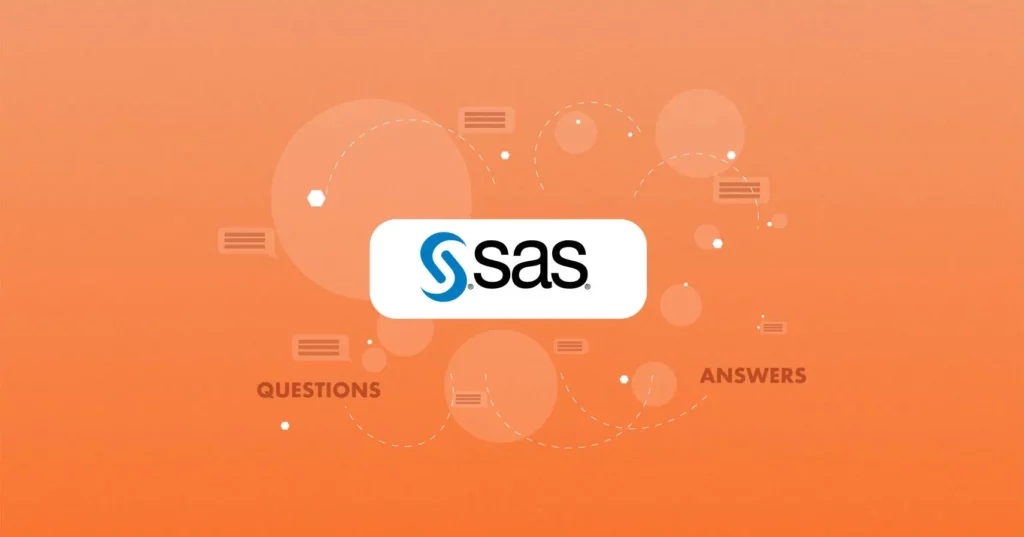Top 15 SAS Interview Questions and Answers [UPDATED 2024]

Table of content
SAS is the most widely used data analytics software on the market. This article is an excellent resource for learning all of the topics necessary to pass a SAS interview. We have separated the questions depending on their difficulty levels, which will let readers with varying degrees of experience get the most out of our site. The SAS Interview Questions blog will be a one-stop resource for enhancing your interview preparation. Now, let’s jump to the table of content.
![SAS Interview Questions [Infographic]](https://uploads-ssl.webflow.com/60191dad58754e0475bdfbcf/6222287c9806b91390982f07_Custom%20dimensions%201500x2500%20px%20(1).png)
SAS is the most widely used data analytics software on the market. This blog is an excellent resource for learning all of the topics necessary to pass a SAS interview. We have separated the questions depending on their difficulty levels, which will let readers with varying degrees of experience get the most out of our site. The SAS Interview Questions blog will be a one-stop resource for enhancing your interview preparation.
Before we go into SAS interview questions, let’s have a look at why SAS is so essential. SAS is simple to learn and gives an easy option (PROC SQL) for individuals who are already familiar with SQL. When it comes to processing large amounts of data and concurrent calculations, SAS is on par with other top tools, including R and Python. SAS is the global market leader in accessible corporate positions. In India, SAS holds around 70% of the data analytics market share, compared to 15% for R.
The SAS interview questions and answers presented in this article are well handpicked by professional hiring managers who have years in the field. Despite the fact that the SAS interview questions and answers are fair enough to prepare for your SAS, but exerting more research would be harmless.
SAS Interview Questions and Answers
Pay extra attention to these SAS interview questions and answers because every question is aiming to leave a great first impression on the interviewer.
What is the function of the output statement in a SAS Program?
To store summary statistics in a SAS data collection, use the OUTPUT statement. This data may subsequently be utilized to generate customized reports or store historical data about a procedure. You can use the OUTPUT statement to:
- Specify which statistics you should save in the output data collection.
- Give the output data collection a name, and
- The CAPABILITY function automatically computes and stores percentiles.
What is the difference between using the drop = data set option in the data statement and the set statement?
If you do not want specific variables to process and do not want them to seem in the new data set, use the drop = data set option in the set statement. If, on the other hand, you want to process certain variables but do not want them to show in the new data set, use the drop = data set option in the data statement.
What is the difference between reading data from an external file and reading data from an existing data set?
The key distinction is that when using the SET command to read an existing data set, SAS keeps the variable values from one observation to the next. When data went through from an external file, just the observations are in place. To use the variables, they must be re-declared.
What are the main features of SAS?
- In compared to other BI (Business Intelligence) systems, SAS provides comprehensive capability for programmatically converting and analyzing data.
- In compared to other BI (Business Intelligence) systems, SAS provides comprehensive capability for programmatically converting and analyzing data.
- SAS is also a platform-agnostic program, meaning it can operate on practically any operating system, including Linux, Windows, Mac OS X, and Ubuntu.
- Its USP is that it allows for extremely precise control over data modification and analysis.
- SAS is a comprehensive data analysis tool that includes everything from simple graphs to complex analyses. The SAS software’s Inbuilt Library, which contains all of the essential packages for data analysis and reporting, is one of its strongest features.
- Graphs ranging from basic scatter plots and bar graphs to complicated multi-page categorization panels can be used to illustrate the findings.
- Another aspect of SAS is its ability to work with a variety of data types. SAS can read data from a wide range of file kinds and formats, including files with missing data.
- SAS has an easy-to-learn syntax since it is a 4GL (4 Generation Programming Language), which is an important attribute.

SAS Interview Question N°5: What are the differences between PROC MEANS and PROC SUMMARY?
When using a BY statement and the input data has already been group by the BY variables, PROC MEANS generates subgroup statistics.
PROC SUMMARY generates statistics for all subgroups automatically, providing all the information in a single run that would be seen over by repeatedly sorting a data set by the variables that characterize each subgroup and executing PROC MEANS. PROC SUMMARY does not generate any data in your output. To see the generated statistics, use the OUTPUT command to set up a new DATA SET and PROC PRINT.
Provide me with an example where SAS fails to convert character value to numeric value automatically?
Assume the variable PayRate’s value starts with a dollar sign ($). When SAS attempts to automatically convert PayRate data to numeric values, the dollar sign prevents the process from proceeding. It is impossible to transform the values into numbers. As a result, whenever conversions occur, it is always advisable to include INPUT and PUT functions in your applications.
What is the difference between do-while and do-until?
When evaluating the DO WHILE phrase at the top of the DO loop, which is a significant distinction between the DO UNTIL and DO WHILE statements. If the expression is false on the initial evaluation, the DO loop will never run. DO UNTIL, on the other hand, executes at least once.
If a variable contains only numbers, can it be a character data type?
Yes, the variable’s use is dependent. Some numbers are in place as a categorical value rather than a quantity. A variable named “Foreigner” is an example of this, with the observations having the value “0” or “1” signifying not a foreigner and foreigner, respectively. Similarly, the ID of a single table might be a number but does not explicitly reflect any amount. Another common example is phone numbers.
What can be the size of the largest dataset in SAS?
The only limit to the number of observations is the computer’s ability to deal with and store them.
SAS data sets may include up to 32,767 variables prior to SAS 9.1. The maximum number of variables in a SAS data collection in SAS 9.1 is bounding by the computer’s resources.
Provide me with examples where PROC REPORT’s defaults are different than PROC PRINT’s defaults?
- There should be no Record Numbers in Proc Report.
- PROC REPORT uses labels as headers.
- Option NOWINDOWS.
What is the difference between the Order and Group variable in the proc report?
Group variables help you categorize your data into multiple groups defined by the number of rows. While Group variables provide a list report, whereas order variables generate a summary report
What is the difference between PROC MEANS and PROC Summary?
The primary distinction between the two processes is that PROC MEANS generates a report by default. To generate a report in PROC SUMMARY, but, you must add a PRINT option in the PROC SUMMARY statement.
Describe the CROSSLIST option in the TABLES statement?
When you add the CROSSLIST option to the TABLES statement, ODS creates crosstabulation tables in column format.
What is interleaving in SAS?
Interleaving merges several sorted SAS data sets into a single sorted SAS data set. The image below depicts the value of the variable used to sort the data sets for each observation. You can interleave data sets by using a SET statement and a BY statement.
What is the difference between One to One Merge and Match Merge?
A one-to-one merge is appropriate if both data sets in the merge statement are all together by ID and each observation in one data set has a matching observation in the other data set.
By this point, you’ve probably noticed that SAS interview questions aren’t as challenging as they seem. But, it is crucial to note that SAS interview questions are not difficult or tough to answer; they are straightforward and straightforward; even so, what makes the process of nailing SAS interview questions so challenging is the preparation.
Conclusion
Since the conversation is revolving around interview preparation, we feel obligated to bring up Huru. Huru is an AI-driven app that is designed to assist job seekers and students prepare for job interviews by providing them with cutting-edge technology from deep and instant feedback to the chance to be hired.
Huru helped thousands of candidates to land their dream job by teaching them tips and tricks on how to ace any job interview on the way through hundreds of mock interviews and deep analysis of voice, body language, language, and much more. Besides helping hundreds of candidates ace their job interviews, Huru has introduced many unique features to the table including:
Customized Mock Interviews: We will construct an interview for you based on any job ad on prominent job boards, allowing you to practice your interview skills and mimic the interview process itself. Simply go to your job offer website, scan the QR code with our chrome extension, and begin practicing your interview.
+ 20K Interview Questions: Get access to a vast selection of interview information that covers virtually every job category, from entry-level to senior roles, and everything in between. Huru meticulously selects each job interview by handing it over to competent real-world recruiting managers from large corporations.
Instant Feedback: Receive quick feedback on your responses and the personality you project during each interview to boost your confidence. At the heart of a good interview experience is our accurate Feedback AI.
Answer Tips: Like a know-it-all coach, Huru offers suggestions for every job interview question. It will assist you in highlighting your abilities.
Live Coaching: Huru may help you overcome your nervousness and display outstanding facial expressions by offering real-time feedback if you want to practice your facial expressions while speaking with an interviewer.
Chance to be Hired: Huru will estimate your chances of getting recruited by analyzing your responses to job interview questions.
Exuded Personality: Huru can give you the personality you exude during each simulated interview based on how you answer the questions.
Speech Analysis: Huru has the ability to analyzes your pauses and tempo to determine how you talk and offers suggestions on how to enhance your delivery.
Interview Recording: If you select video mode, interviews are only recorded on your smartphone, allowing you to review them afterwards to assess how well you performed.
The list of Huru’s new and unique features can still go on and on. At the end of the day, SAS interview questions or even the interview itself are not difficult; it is the interview preparation process that is difficult. For this specific reason, Huru was invented.
Good Luck.

Elias Oconnor
Senior Copywriter